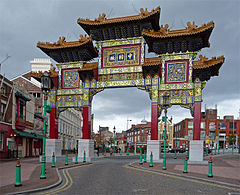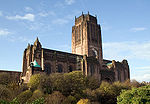- Chinatown, Liverpool
-
Coordinates: 53°23′58″N 2°58′36″W / 53.3995°N 2.9768°W
Chinatown 
Chinatown Gate, Nelson Street
 Chinatown shown within Merseyside
Chinatown shown within MerseysideOS grid reference SJ3505490776 Metropolitan borough Liverpool Metropolitan county Merseyside Region North West Country England Sovereign state United Kingdom Post town LIVERPOOL Postcode district L1 Dialling code 0151 Police Merseyside Fire Merseyside Ambulance North West EU Parliament North West England UK Parliament Liverpool Riverside List of places: UK • England • Merseyside The Chinatown in Liverpool, England (Chinese: 利物浦 唐人街 pinyin:lì wù pŭ táng rén jiē) is located near the city centre's southern edge close to Liverpool Cathedral, and is home to the oldest Chinese community in Europe.[1] The arch located at the gateway is also the largest, multiple-span arch of its kind outside of China, the largest single-span arch being located in Washington D.C.[2] 2007 estimates state 1.7% of Liverpool's population as being of full Chinese descent (some 7,400 people), making it the city's single largest non-White ethnic group.[3] The International Organization for Migration, by contrast, has estimated that the number of Chinese people in Liverpool could range between 25,000 and 35,000.[4]
Contents
History
19th–20th centuries
The first presence of Chinese people in Liverpool dates back to 1834 when the first vessel direct from China arrived in Liverpool's docks to trade such goods as silk and cotton wool.[5] Many Chinese immigrants first arrived in Liverpool in the late 1850’s as a result of Alfred Holt and Company employed large number of Chinese seamen while establishing the Blue Funnel Shipping Line. The commercial shipping line created strong trade links between the cities of Shanghai, Hong Kong and Liverpool; mainly importing silk, cotton and tea.[6] From the 1890s onwards, small numbers of Chinese began to set up businesses catering to the Chinese sailors working on Holt's lines and others. Some of these men married working class British women, resulting in a number of British-born Eurasian Chinese being born in Liverpool.[6]
World War II
At the beginning of the War, there were up to 20,000 Chinese mariners in the city. In 1942, there was a strike for rights and pay equal to that of white mariners. The strike had lasted for four months. For the duration of the War these men were labelled as "troublemakers" by the shipowners and the British Government. At the end of the conflict, they were forbidden shore jobs, their pay was cut by two-thirds and they were offered only one-way voyages back to China. Hundreds of men were forced to leave their families, with many of their Eurasian children continuing to live in and around Liverpool's Chinatown to this day.[7]
Liverpool's first Chinatown existed within the city's docklands, although heavy bombing during World War II lead to a relocation of its current location just west of Liverpool Cathedral.
Recent history
Although the Chinese population in Liverpool is much smaller than it was mid-20th century the city's Chinatown district has spread significantly since its first establishment, now taking up much of Berry Street. The Chinese Arch was assembled in 2000 (after being built in one of Liverpool's twin cities - Shanghai) as a mark of redevelopment of the area, which is still continuing today. The streets of Liverpool's Chinatown are decorated with Chinese-style lanterns, waste bins and all street signs are written in English and Chinese. Chinese owned restaurants, supermarkets (including Chung Wah and Hondo), book shops and other businesses are now spread throughout the district. Chinatown is also home to many community organisations as well as the Liverpool Chinese Gospel Church and the Liverpool Chinese Christian Disciples Church.
Plans to redevelop a significant portion of Chinatown were revealed in October 2010.[8] The scheme named 'China Square' is to include a Chinese Cultural Museum and Courtyard by Marriott in the former Scandinavian Hotel building.[9]
Arch
Planning for an arch began in 1992 as part of a regeneration scheme by Liverpool City Council for the Chinatown area, designs for the arch were chosen by the local Chinese community through a competition.[5] Initial construction began in October 1999 with the arrival of 20 specially selected craftmen from Liverpool's twin city of Shanghai. The craftsmen included stonemasons, stone carvers, painters and construction engineers.[5] Along with the Chinese workers, block components manufactured by The Shanghai Linyi Garden Company Ltd where also shipped from China to Liverpool in five large containers with 2,000 pieces.[5] [10] Overall design was co-ordinated through the architectural practice of Wilkinson Hindle Hallsall and Lloyd with Liverpool City Council providing engineering design and supervision of the infrastructure and structural frame to the arch. Work finished in a relatively short time period of 90 days. This was due to the Chinese workers not traditionally celebrating Christmas and Boxing Day meaning that they could carry on working. Building of the arch finished in 2000 and was officially opened on Chinese New Year at a final cost of £ 700,000.[11]
Features
Standing at 13.5 metres (44 ft) high the arch is the tallest in Europe and the second tallest in any Chinatown outside of mainland China.[12] (Washington D.C having the tallest outside China at 47ft.)[13]
The arch boasts 200 hand carved dragons of which 188 are ordinary and 12 are pregnant, the meaning of which is to symbolize good fortune between Liverpool and Shanghai.[5] In the center of the arch; golden Chinese characters 中国城 (written backwards on arch) translate as "Chinatown".[14] In 2010 as part of a £25,000 lighting scheme, multicoloured, low energy illuminating lights were added to the arch as a way to highlight one of Liverpool's significant structures.[15]
Streets
- Bailey Street - 貝利街
- Berry Street - 巴利街
- Cornwallis Street - 康和利士街
- Cummings Street - 卡明斯街
- Duke Street - 公爵街
- Griffiths Street - 居富士街
- Knight Street - 勵德街
- Nelson Street - 納爾遜街
- Roscoe Lane - 羅士高里
- Sankey Street - 桑基街
- Seel Street - 兆街
- Upper Duke Street - 上公爵街
References
- ^ "Liverpool Chinatown Museum". Dimsum. http://www.dimsum.co.uk/community/liverpool-chinatown-museum.html. Retrieved 21 November 2008.
- ^ "Chinese Arch". Visit Liverpool. http://www.visitliverpool.com/site/chinese-arch-p54681. Retrieved 21 November 2008.
- ^ "Neighbourhood Statistics". Office of National Statistic. http://neighbourhood.statistics.gov.uk/dissemination/LeadTableView.do?a=3&b=276787&c=Liverpool&d=13&e=13&g=359393&i=1001x1003x1004&m=0&r=1&s=1201810428109&enc=1&dsFamilyId=1812. Retrieved 31 January 2011.
- ^ "China Mapping Exercise". International Organization for Migration. http://www.iomlondon.org/doc/mapping/IOM_CHINA.pdf. Retrieved 20 April 2008.
- ^ a b c d e "History of Liverpool Chinatown". The Liverpool Chinatown Business Association. http://web.ukonline.co.uk/lcba/ba/history.html. Retrieved 31 January 2011.
- ^ a b "Liverpool Chinatown History". Liverpool Chinatown. http://www.liverpoolchinatown.co.uk/history.html. Retrieved 31 January 2011.
- ^ "Liverpool and it's Chinese Seamen". halfandhalf.org.uk. http://www.halfandhalf.org.uk/. Retrieved 31 January 2011.
- ^ "Let’s aim high for Liverpool’s Chinatown". Liverpool Echo. http://www.liverpoolecho.co.uk/views/our-view/2010/10/15/let-s-aim-high-for-liverpool-s-chinatown-100252-27475363/. Retrieved 10 January 2010.
- ^ "Plans revived for new hotel to replace city’s derelict Scandinavian Hotel". Liverpool Echo. http://www.liverpoolecho.co.uk/liverpool-news/local-news/2011/01/10/plans-revived-for-new-hotel-to-replace-city-s-derelict-scandinavian-hotel-100252-27957066/. Retrieved 10 January 2010.
- ^ Herbert, Ian (33 March 2000). "Liverpool pips its arch rival with gateway to Chinatown". The Independent. http://www.independent.co.uk/news/uk/this-britain/liverpool-pips-its-arch-rival-with-gateway-to-chinatown-724160.html. Retrieved 18 February 2011.
- ^ "Chinese Arch". Dowhigh Ltd. http://www.dowhigh.co.uk/casestudies.php?caseStudyID=12. Retrieved 16 February 2011.
- ^ "Liverpool's Chinese arch ten years standing". BBC. 19 February 2010. http://news.bbc.co.uk/local/liverpool/hi/people_and_places/arts_and_culture/newsid_8522000/8522792.stm. Retrieved 18 February 2011.
- ^ "Friendship Archway, (sculpture).". Smithsonian Institution Research Information System. http://siris-artinventories.si.edu/ipac20/ipac.jsp?&profile=all&source=~!siartinventories&uri=full=3100001~!325492~!0#focus. Retrieved 18 February 2011.
- ^ "Cantonese Dictionary". cantonese.sheik.co.uk. http://www.cantonese.sheik.co.uk/scripts/wordsearch.php?level=0. Retrieved 18 February 2011.
- ^ "Chinatown welcomes illuminated arch". placenorthwest.co.uk. 10 November 2010. http://www.placenorthwest.co.uk/news/archive/7618-chinatown-welcomes-illuminated-arch.html. Retrieved 18 February 2011.
See also
External Links
Coordinates: 53°23′58″N 2°58′36″W / 53.3995°N 2.9768°W
Locations of Liverpool City Centre Albert Dock · Canning · Cavern Quarter · Chinatown · Commercial District · Concert Square · Cultural Quarter · Gay Quarter · Hope Street Quarter · King's Dock · Knowledge Quarter · Liverpool One · Pier Head · Princes Dock · RopeWalks ·Buildings and structures in Liverpool, England Skyscrapers and highrises 1 Princes Dock · Alexandra Tower · Beetham Tower · Mann Island Buildings · Municipal Buildings · New Hall Place · One Park West · The Plaza · Port of Liverpool Building · Post & Echo Building · Radio City Tower · Royal Liver Building · Thistle Atlantic Tower · Unity Commercial · Unity Residential · West Tower



Notable lowrises Albert Dock · Alder Hey Children's Hospital · Bank of England · Bluecoat Chambers · Britannia Adelphi Hotel · Chinese Arch · County Sessions House · Crowne Plaza LJLA · Cunard Building · Empire Theatre · Everyman Theatre · Grand Central Hall · Great North Western Hotel · Hargreaves Building · Hilton Liverpool · India Buildings · International Slavery Museum · Liverpool Central Library · Liverpool Cotton Exchange Building · Liverpool Magistrates' Court · Liverpool Playhouse · Liverpool Town Hall · Liverpool Women's Hospital · The Lyceum · Malmaison · Merseyside Maritime Museum · Museum of Liverpool · National Conservation Centre · Oratory · Oriel Chambers · Philharmonic Hall · Prudential Assurance Building · Queen Elizabeth II Law Courts · Royal Court Theatre · Royal Insurance Building · Royal Liverpool University Hospital · Speke Hall · Stanley Dock Tobacco Warehouse · St. George's Hall · Tate Liverpool · Tower Buildings · Victoria Building · Walker Art Gallery · White Star Building · World Museum Liverpool
Places of worship All Saints' Church · Al-Rahma Mosque · Church of All Hallows · Church of St Agnes and St Pancras · German Church · Greek Orthodox Church of St Nicholas · Gustav Adolfus Kyrka · Liverpool Cathedral · Liverpool Metropolitan Cathedral · Norwegian Fishermans' Church · Old Christ Church · The Oratory · Princes Road Synagogue · St George's Church · Saint John the Baptist's Church · St Luke's Church · St Luke's Church, Walton · St Michael's Church · Toxteth Unitarian Chapel · Unitarian Chapel · Welsh Presbyterian Church
Transportation Shopping complexes Sports venues and arenas Anfield · Echo Arena · Goodison Park · Liverpool Cricket Club · O2 Academy Liverpool · Wavertree Athletics Centre
Sculptures and monuments Nelson Monument · Superlambanana · Titanic Memorial · Wellington's Column
Lists  CategoryCategories:
CategoryCategories:- Visitor attractions in Liverpool
- Culture in Liverpool
- Districts of Liverpool
- Chinese community in the United Kingdom
- Chinatowns in Europe
- Ethnic enclaves in the United Kingdom
Wikimedia Foundation. 2010.






